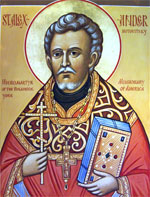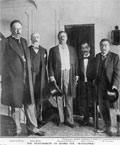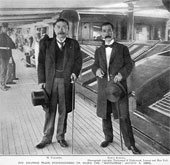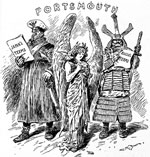
Place, Part Two: New York, Sagamore Hill, and Oyster Bay, continued . . .

Icon of St. Alexander Hotovitzky. Courtesy of St. Peter and Paul Church, South River, NJ. View larger image.
On August 4, Witte and Rosen attended a service conducted by Archpriest Alexander Hotovitzky at St. Nicholas Russian Orthodox Church. Aware of the great responsibility facing Witte, Hotovitzky said, in part, "A hard and difficult task lies before you. May God help you and grant you wisdom. Just now we all feel lost and do not know what to do or what the future will bring. But I am sure that you, with your Russian soul, understand and know exactly what is necessary for the good of Russia." Hotovitzky, who would participate in the Portsmouth religious service on the day the treaty was signed, later returned to Russia where the communists charged him with counter-revolutionary activities. He was arrested and imprisoned several times, the last in 1937, after which he disappeared and was assumed to have been martyred. He was made a saint of the Orthodox Church in 1993.
After the service, Witte and Rosen met Roosevelt at Sagamore Hill where the Russians insisted they would make no payment to the Japanese. Without a Japanese change of mind regarding the money, the Russians insisted their country would continue the war. Roosevelt and Witte had several disagreements and the president recalled the meeting as being unpleasant. After these visits, Roosevelt was not hopeful that a treaty could be achieved, nevertheless, he urged the parties to continue as planned.
On August 5, the delegations were introduced to each other on board the USS Mayflower in Oyster Bay, off ashore from Sagamore Hill. The Japanese arrived from New York on the cruiser Tacoma and were the first to board the Mayflower where President Roosevelt greeted them. Soon after, the Russians arrived on the cruiser Chattanooga. They joined the Japanese and the president for a champagne toast and a cold luncheon. No chairs were provided, thereby eliminating any problems of seating arrangements. Protocol for such gatherings was important and, as hosts, American officials were careful not to slight either Russia or Japan. It had originally been determined that the Russian party had precedence because their embassy in Washington was headed by an ambassador while Japan had only a minister. For the preliminary meetings, the order was reversed because the Japanese were the first to arrive in this country for the conference.

President Roosevelt Boards the Mayflower. Harper's Weekly. View larger image.

Witte on the Mayflower. Harper's Weekly. View larger image.

Komura on the Mayflower. Harper's Weekly. View larger image.

President Roosevelt introduces the Russian and Japanese delegations to each other. Harper's Weekly. View larger image.
Careful to maintain his neutrality, Roosevelt offered a toast to which he would not accept a reply, "I drink to the welfare and prosperity of the sovereigns and people of the nations whose representatives have met one another on this ship. It is my most earnest hope and prayer, in the interest not only of these two great powers, but all of civilized mankind, that a just and lasting peace may speedily be concluded between them."
Immediately after the toast the parties disembarked for New Hampshire. For the trip to Portsmouth, the Japanese boarded the USS Dolphin, chosen for them because most of the servants were Japanese, while the Russians remained on the Mayflower, which had Chinese servants. The two ships were escorted by the Galveston carrying Secretary Peirce. Fog in Long Island Sound delayed the progress of the flotilla causing the conference to be postponed for one day.

A famous group portrait of, left to right: Witte, Rosen, Roosevelt, Komura, and Takahira on board Mayflower. Portsmouth Athenaeum collection. View larger image.

Komura and Takahira on board the Dolphon en route to Portsmouth. Harper's Weekly. View larger image.

